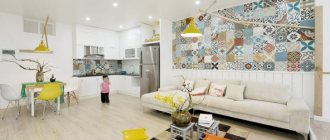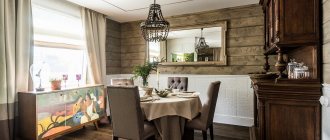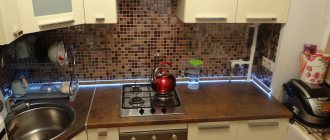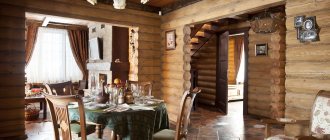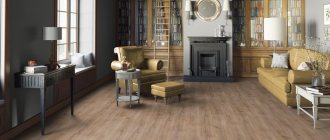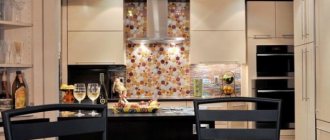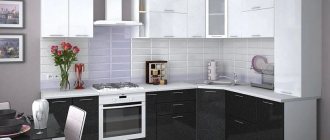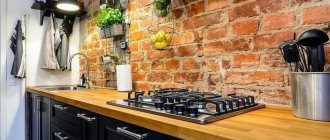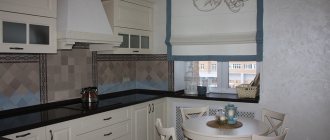From time immemorial, practical housewives and needlewomen have used patchwork techniques to make blankets, bedspreads, and capes from the remains of various materials. Now the trend with the foreign name “patchwork” has again become incredibly popular.
Moreover, the scope of its application has expanded significantly. Modern technologies have made it possible to use this decor in the production of ceramic tiles. The world's leading brands produce finishing materials that can transform the environment, give it charm and originality. The patchwork style looks especially good in the kitchen interior.
Features of a patchwork kitchen
Using patchwork you can create an accent
It is impossible to overestimate the role of the kitchen. The attractiveness and functionality of its interior are undoubtedly important. But not only these factors need to be taken into account when decorating the interior. The mood of the hostess, the taste and quality of the dishes, and the atmosphere of family relationships depend on the degree of coziness and comfort in this room. Patchwork style in the kitchen will help create the required conditions, turn it into an oasis of warmth, a source of good mood. Cheerful, bright “rugs” on the walls:
- the warmth of the family hearth is emphasized;
- will relieve boredom and help take your mind off sad thoughts;
- will create a desire to create culinary masterpieces;
- will provide a pleasant atmosphere during family meals and friendly meetings.
Wall decoration, panels or patchwork aprons in the kitchen are an expressive, interesting accent. Such elements guarantee originality to the interior, which is fully consistent with today's fashion trends.
The brighter the tiles in the patchwork style, the other elements of the interior are decorated in soothing colors
Photos of kitchens in the patchwork style demonstrate the ability of this decor to successfully complement a variety of styles. You can use it in classic and modern directions.
Sizes and formats of patchwork tiles
Standard sizes of floor and wall tiles in a patchwork style are 10*10 cm, 20*20 cm, 25*40 cm, 30*30 cm, 45*45 cm. There are also large formats 60*60 cm for floor coverings and tiles made “made to order”, taking into account the wishes of clients. When choosing a coating, be sure to correlate the size of the room with the dimensions of the ceramic finish . For example, in a small bathroom you should use minimal tiles - 10*10 cm or 20*20 cm. And larger patterns are suitable where the area of the room exceeds 10 square meters. m.
Don't miss: How can you paint ceiling tiles? Painting ceiling tiles: choosing paint and tools, surface preparation and painting technology
Materials and patterns
When choosing a tile, you need to take into account the scope of its application - it can be designed for cladding walls or floors, which must be marked on the packaging. Patchwork tiles are available in two versions: ceramic and, more durable, porcelain stoneware. The surface texture can be smooth or rough, have a reflective shine or dullness. Which one to choose depends on the personal preferences of the owners, as well as the interior design (rustic styles are characterized by matte surfaces, sometimes with elements of aging, while the modern high-tech direction is closer to gloss and gloss).
Drawings of various colors and contents are applied to the surface of the tile using digital printing. The most popular today are white-black, white-blue and beige patterns. They can be represented by abstractions, graffiti, geometric shapes, and ornaments. Tile manufacturers honor new fashion trends and reflect this in their products. If checkered fabric becomes the trend of the coming year, a new collection of similar patchwork tiles will definitely appear. However, you should not rush to keep up with fashion - patterned decoration should be harmoniously combined with the general atmosphere of the interior, its style and color scheme. Tiles made in bright colors should be present sporadically, since over time, oversaturation with bright colors will cause irritability.
Options for using patchwork in the kitchen interior
Patchwork tiles for the kitchen are offered in different versions. The charm of this finishing material is beyond doubt. But it is necessary to use it in the interior in limited quantities. The abundance of variegation inherent in patchwork can spoil the impression.
Like a rug, patchwork tiles are the centerpiece of the decor.
Patchwork tiles in the kitchen are used to create an accent. This capacity may include:
- apron;
- one wall;
- horizontal panel on the walls;
- floor;
- insert or panel;
- textile.
an apron in a patchwork style in bright colors will please the eye
The most popular use of this material is to decorate the space between wall cabinets and the lower tier of furniture. Using patchwork tiles in a kitchen backsplash can be considered the best option. In terms of strength and resistance to negative influences, this material fully meets the requirements. A colorful, playful patchwork apron in the kitchen will provide the hostess with a boost of vivacity and good mood.
One kitchen wall with patchwork tiles can become a successful design accent. This technique is ideal if the interior of the room turns out to be too laconic and faceless. In addition, with the right selection of shades, this design will help visually adjust the room. You can use designer photos of kitchens in patchwork style as a guide.
patchwork style cushion on kitchen chairs as an element of kitchen decor
A fashionable design trend now is a combined finish that divides the walls into two parts horizontally. Patchwork tiles in the kitchen will not only create an original wall design, but will also simplify the cleaning process. The lower part of the walls, lined with such material, will be easy to clean from dirt, which is difficult to avoid in this room.
A patchwork tile floor looks perfect in a kitchen interior. It successfully imitates a cozy rug and makes the room feel comfortable. Durable material will not lose its properties from regular washing or exposure to household chemicals, and will retain its pristine beauty for many years.
Patchwork kitchen tiles in black and white tones are ideal for kitchens decorated in a modern style
It is not always advisable to use this style for large-scale elements. The accent may take up a small space. You can create a patchwork panel from tiles in the kitchen, and use this decor as an effective insert in a plain finish. Since it provides an atmosphere of warmth and comfort, it is appropriate to use such decoration in the dining area. It does not require high strength or stability of materials. You can make a patchwork panel for the kitchen with your own hands from textiles and other available materials.
An apron in a patchwork style attracts attention the first time
Textiles in this design look impressive and interesting. Such products can be found in a modern assortment. Craftswomen will be able to make patchwork-style items for the kitchen with their own hands.
Types of tiles
Whatever your kitchen design, you can use the wide range of tile materials on the market to find the perfect match without having to plan an additional wall layout to go with your new decor.
Patchwork in beige
- Quartz : Bring extra sparkle to your kitchen in the form of quartz kitchen tiles. This beautiful decorative Patchwork will be the epitome of elegance and will be the focal point and key theme of the design. Available in a range of heavenly shades including black, blue, aquamarine. This solution can also be used for glamorous floor tiles.
- Porcelain tile : If you're looking for something completely natural but aren't keen on the shimmery quartz finish, there are plenty of porcelain tile kitchen tiles available.
Stone patchwork, polished marble and warm autumn travertine will bring true beauty and sophistication.
Quartz will add extra sparkle to your kitchen
- Cement Patchwork : Unlike ceramics and clay, it does not need to be fired, it is done by hand and conveys unique colors.
- Ceramic : Best for kitchen surfaces. Ceramics come in a vibrant range of color schemes and patterns. Whether you want to customize an exotic Moroccan aesthetic or a Spanish-inspired Mediterranean mosaic, patchwork will bring any mood to the room, from retro appeal to inspired by global interior design trends.
- Non-slip : If you and your family spend a lot of time in the kitchen, safety is a factor that cannot be ignored. In addition to being easy to clean and able to withstand daily wear and tear, kitchen floor tiles should be slip-resistant.
The non-slip kitchen Patchwork combines a range of practical properties with a variety of design options, and you can find it in a variety of materials, from porcelain tiles to luxurious brushed ceramics.
Interesting design with bright elements
Patchwork tile floors and walls using ceramics are incredibly popular. Often this decor is used in white kitchen designs, where there is ample scope for creativity due to the versatile and spacious feeling that is characteristic of white rooms.
Although a patchwork design may seem like a random mishmash of tiles, planning a skillful design requires planning and thoughtful choices.
Even professional designers are forced to use several different layouts for one project to achieve a harmonious result.
Apron with geometric print
Variety of patchwork
A significant attractive factor of patchwork tiles for the kitchen is the variety of types, themes, and shades. There are no restrictions in creating decor for these materials, which provides designers with complete freedom of creativity. In the decoration of walls, floors, patchwork aprons for the kitchen you can see drawings in the following themes:
- vegetable,
- floral,
- ethnic,
- geometric,
- animalistic,
- fantasy, etc.
Decorating the floor and backsplash with ceramic tiles in patchwork style
You can choose the material based on the canons of style, personal interests, and preferences.
Patchwork tiles for the kitchen differ not only in the theme of the prints. In the category of this finishing there are colored materials, made in several tones of the same range. This provides the opportunity to implement various creative patchwork ideas for the kitchen.
Styling tips
Patchwork allows you to combine different textures into one whole, that is, you can combine glossy tiles with matte ones, imitation of natural texture (wood, stone) with patterned fragments. A glossy surface is more suitable for a kitchen backsplash and is easier to keep clean. Matte tiles are safer on the floor; they reduce the risk of accidentally slipping on a wet surface.
Patchwork tiles with a raised pattern look very attractive, but they are not very practical for the kitchen. It is difficult to care for, as dust and dirt get stuck in the recesses. Also, you should not choose patchwork fragments with a mother-of-pearl or metallized coating for your kitchen apron. As a rule, such tiles do not tolerate aggressive detergents well.
You can lay out the tiles randomly or in a certain order, repeating the pattern. The easiest way is traditional laying in squares, but combinations of rhombuses or tiles with a figured edge are also possible.
The following combinations of patterns are found in ready-made tile sets:
- floral ornament with rounded smooth lines and sharp geometric patterns;
- smooth tiles without a pattern alternate with ornamented fragments;
- Some tiles have a small and faint meaningful design.
The brighter and more contrasting the pattern, the more difficult it is to fit it harmoniously into the interior. Nowadays, combinations of white with blue, beige, and gray are especially popular. This is a fairly calm combination. It will not create uncontrollable chaos and an “explosion of color.”
Important! The smaller the kitchen, the smaller the size of the patchwork tiles should be. Lay tiles with a side of 10-15 cm on the apron. For the floor you can take 20-25 cm or more. But do not forget that too large fragments visually make the kitchen smaller.
Combining patchwork accents
When decorating a kitchen in a patchwork style, you need to take into account the features of this decor. You should not only limit its use and avoid excessive variegation, but also wisely combine this finish with other interior elements.
A bright and colorful patchwork sofa will become the main accent in a white kitchen
There are several recommendations from professional designers for using the patchwork style in the kitchen interior:
- patchwork is not used simultaneously in wall and floor decoration, textiles;
- the colors used in the decorative patterns must be combined with the main tones of the interior;
- bright designs use calm monochrome options;
- Patchwork style accents look good on a plain background;
- There is no need to use a lot of decorative elements in the interior if there is decor in this style.
Compliance with these rules will help you design a harmonious kitchen interior in a patchwork style and eliminate unnecessary variegation, which is a sign of bad taste.
How we positioned the equipment
We built in large appliances, except for the refrigerator. The oven and microwave were placed in the pencil case. The oven is slightly higher than a regular stove, so it’s convenient to take pies out of it - you don’t have to bend over too much.
Microwave at chest level. If it were higher, it would be inconvenient. We bought a large dishwasher, 60 cm. It includes a lot of dishes and large baking sheets.
Types of decoration, patchwork style decorations
Tablecloth for table in patchwork style
Now the most popular option is patchwork tiles in the kitchen. The widespread use of this material is due to its ideal functional characteristics that correspond to the specifics of the kitchen. Ceramic cladding can withstand difficult indoor conditions and has a long service life. You can decorate a kitchen apron with patchwork tiles, make the work area attractive, without spending a lot of time and effort to maintain cleanliness.
Hot stand in patchwork style
It is not necessary to limit yourself to these materials in interior design. High popularity contributes to the expansion of the range of decor. The simplicity of the technique makes it possible to create various patchwork-style items in the kitchen with your own hands. In creating the interior the following can be used:
- wallpaper;
- curtains;
- napkins and potholders;
- covers;
- rugs, etc.
Decorative elements in patchwork style
In the products of leading manufacturers for kitchens in a patchwork style, you can choose vinyl wallpaper that imitates patchwork technology. This material can be used in kitchen decoration. It has high strength, stability, and is suitable for wet cleaning. There are fabrics with such decor that can be used in sewing curtains and other items. On the Internet, needlewomen can find patterns for patchwork pot holders for the kitchen, curtains, covers for stools, etc.
How to sew kitchen accessories from scraps?
Patchwork elements can be not only triangular. In geometric techniques, stripes, rectangles, and hexagons are used (quilting). Free technique involves the use of cut-out parts of a design of any configuration, used as parts of a panel or appliqués sewn on top of it. This gives scope for the imagination and creativity of craftswomen who create real masterpieces from scraps.
Patterned border for kitchen towel
Stages of patchwork sewing.
It’s quite simple to practice creating patchwork patterns using the geometric technique: to do this, we sew a border for a kitchen towel, like on. You will need to prepare:
- fabric in ocher, red and green shades with any pattern;
- towel;
- sewing machine, thread and needle, pins;
- scissors, ruler with protractor, chalk or pencil.
For the central motif of the border, cut strips: 2 pcs. ocher color, size 4x100 cm, 2 pcs. red stripes 2.5x100 cm, 1 pc. green - 3.5x100 cm. Relate them to each other in the order shown in the diagram. To join, place 2 strips right sides on top of each other, baste or pin along the edge and stitch by machine. Repeat with other strips until you have a wide strip. Iron the seams in pairs: the 1st and 2nd towards each other, the 3rd and 4th in the same way. On the inside they will be under a red stripe.
Patchwork techniques.
Mark the diagonal elements, setting an angle of 45° relative to the sides of the strip and cut it according to the markings (3). The width of such a fragment is 4 cm. The finished strips need to be connected into a single strip, shifting them relative to each other (4). The arrow shows how to combine the corners of the central stripe to create a motif. Connect the elements as indicated above to connect the strips. You will need to sew together enough pieces so that the total length of the strip is equal to the width of the towel prepared for finishing. Trim the edges of the strip (5). Its width will be 10 cm.
The next step is to create the edges for the border. To do this, cut 2 strips of each color with a length equal to the width of the towel and a width of 2.5 cm (red), 3 cm (green) and 3.5 cm (ochre). You can first connect these elements together, then sew the edge to the central strip, or sew the edge elements to it one by one. Press the seams towards the center.
Fold and press inside out the edges of the finished border around the entire perimeter by 1 cm. Lay out the towel and place the decorative border on top, face up, choosing the desired location (about 10 cm from the edge of the towel). Baste or pin, make a stitch around the perimeter of the border at a distance of 2 mm from the ironed edges.
Heart shaped pot holder
Heart shaped tack pattern.
For the heart potholder you will need:
- fabric for the main front part;
- fabric for the back (thick, made from natural fibers);
- padding polyester;
- flaps for finishing;
- braid or lace, ribbon for edging;
- sewing machine and measuring tool, scissors.
The tack pattern is shown in the same picture and consists of 2 parts. Part A is cut in one piece, folding the fabric in half when cutting. If you don’t have a piece of fabric of sufficient size, you can cut out and sew halves of part A. You will need 3 pieces of these elements: fabric for the front side, fabric for the back side and padding polyester.
Parts B are used for finishing; they must be cut from scraps of contrasting color. You need to cut out 4 such fragments. so that you can sew them in pairs with the right sides facing out. Topstitch along the outline. Finish the straight edges of parts B with trim, braid or sew on lace.
Lay out parts A: the first face down, place the padding polyester on it, and the third face up. Pin and stitch along the outline. Turn the resulting heart up with the side that will be the face of the product. Place the sewn and finished parts B on the heart as in the picture, pin and stitch only on the rounded side. The straight sides form pockets into which your hand will fit when using an oven mitt. Finish the edges of the heart with braid, starting from the center, and make a loop for hanging. Decorate the place where the loop is sewn with a button or make a flower from scraps of fabric.
How to sew a flower for decoration?
To finish products from scraps, you can quickly make flowers. The pattern consists of 1 round piece for the center and several semi-elliptical petals. Their tops can be made round or pointed. The details of the petals are cut in double quantities in order to sew them in pairs from the wrong side.
Having turned the petals inside out, gather their straight edge onto a thread without tearing it off. Pull it together and close it in a ring. For the center of the flower, cover the button with the stem with a circle of fabric, tying it with thread along the edge. Attach the decor by threading the button stem through the center of the petal ring and sewing it in place.
Patchwork plates
You can also make textile plates of various shapes from fabric scraps. They can be used as oven mitts and hot mats when cooking in a microwave oven. Made from natural fabric, they are not afraid of high temperatures, do not heat up in the microwave and significantly reduce the risk of burns when working with it: we place them in the microwave directly with the dishes and then easily and safely remove the hot pan.
To make a pattern, you need to take measurements from the dishes: from edge to edge, along the bottom of the container. Measure or sew a square, circle or flower from the pieces. Make the same parts for the back and lining from padding polyester, connect everything together, stitch. Turn it onto the face, sew up the hole with a hidden seam (2) and fit it “to the shape” of the pan or cup, making darts. They are made in the middle of the side of a square, along the radii of a circle or between the petals of a flower (3). When textile plates do not perform their main function, they can be used as candy dishes or vases for fruits, cookies, etc. Patchwork for the kitchen will decorate the room, giving it warmth and comfort. The main thing in this matter is maximum imagination and a variety of fabric scraps.
Apron in patchwork style
A patchwork apron for the kitchen is the most popular option. This element becomes a noticeable, expressive accent, gives the work area a cheerful note, and enlivens the interior. Sometimes after large-scale renovations, tiles of different shades, with patterns and plain ones remain. Since the style does not limit the choice of elements, these materials can become components of one composition. However, it is usually not possible to create a beautiful, high-quality patchwork apron in the kitchen in this way.
The patchwork of the apron should clearly match the contours of the surrounding furniture
Many manufacturers offer special design kits. A patchwork apron for the kitchen can be made from:
- ceramic tiles;
- mosaics;
- plastic.
If you purchase standard tiles of different shades to create an accent, you need to choose materials of the same brand. The optimal size of the elements is 10x10. The advantage of this method is the ability to accurately select shades taking into account the features of the interior, and create a unique pattern or ornament.
A bright apron breaks up the monotonous white kitchen interior
A beautiful patchwork apron in the kitchen is made from mosaic. This material is produced from various raw materials. There are glass, metal and ceramic mosaics. Smalt tiles are ideal for kitchens. If the sun's rays fall on it, a glow is formed, giving it a special charm.
Modern technologies make it possible to create plastic that has increased strength and resistance to various influences. Special patchwork tiles for kitchen backsplashes are available in a wide range. For any style you can find the best option.
Laying tiles is not difficult for homely owners. You can create a patchwork apron for the kitchen with your own hands, without involving professional specialists.
Patchworking lesson for beginners on making your own from jeans
When you are tired of wearing denim trousers or sundresses, or they become too small, they can be turned into a really useful and interesting product. In this lesson we will make a bedspread using sewing from scraps and scraps of different fabrics.
| Illustration | Description of action |
| We prepare a sufficient number of flaps of the same size. It is advisable that the process involves two different shades of denim. | |
| We put two pieces of fabric of different colors together. | |
| Draw a diagonal on a light material. In the same way, we fold and draw all the diagonals. | |
| We install the foot diagonally and stitch on one side. We do the same with the other one. | |
| We make a cut along the drawn line and get two identical parts. We do all the squares in the same way. | |
| We iron each fragment well and cut off the protruding corners of the seam from the inside. | |
| We lay out the squares in a certain pattern, then turn them over to face each other. | |
| Now we sew all the parts together one by one. | |
| We combine the required number of parts with each other, and then attach them to the old bedspread, forming an interesting charcoal ornament. | |
| Then we sew an old bedspread or any other fabric on the back side. |
The result is an original blanket that is suitable for decoration and can also be used for other purposes.
Manufacturing of textile decor
Curtains in the kitchen stylized as patchwork
Textile decor in patchwork style looks great in the kitchen interior. It provides maximum comfort, coziness, and adds cheerfulness to the atmosphere. For housewives with sewing skills, it will not be difficult to make original products. You can find on the websites patterns for patchwork potholders for the kitchen, curtains, covers for sofas and chairs, and stools. Many needlewomen will develop decor styles themselves.
Making patchwork items for the kitchen with your own hands allows you to:
- create unique things, give the interior individuality;
- accurately select shades, theme of elements, ensure impeccable harmony;
- find functional uses for unnecessary things.
patchwork style potholders
The absence of restrictions in the choice of materials allows you to use creative imagination and use various scraps that every housewife has. If it’s difficult to come up with options on your own, you can find numerous patchwork ideas for the kitchen on the Internet and choose the best options for your interior.
Unique patchwork panel in the kitchen
A patchwork panel for the kitchen can be an ideal decoration. This type of needlework is sure to captivate creative people who want to realize their ideas. Anyone can make a unique patchwork panel for the kitchen with their own hands, without spending significant money on this decor.
You can make these decorative elements yourself
It is not necessary to use traditional techniques for this. The most interesting option for such decor is quilting. Unlike the classical method, in which the canvas is made up of squares and rhombuses with different designs, a quilt allows you to create full-fledged paintings from scraps. The following may appear on a patchwork panel in the kitchen:
- everyday stories;
- flower arrangements;
- fruit still lifes;
- ethnic ornaments, etc.
A small panel in the kitchen in patchwork style
Fabric scraps are used in production, which every housewife can find. Subject matter and implementation depend on your own preferences and capabilities. There are interesting patchwork ideas for the kitchen on the Internet.
Potholders
Patchwork potholders are practical and decorative.
Their gift sample is a pleasant surprise for loved ones. The main advantage is low thermal conductivity (Also find out how to sew oven mitts for the kitchen with your own hands).
Square potholder
To make it we need:
- cotton fabric;
- threads;
- batting;
- cotton edging.
Procedure
- Let's make a cardboard square - a template and cut it out.
- Apply it to the fabric and outline it with chalk, taking into account the seam allowances.
- Let's cut out 2 of these squares.
- Connect the squares with pins.
- We sweep them away by hand.
- We will make a loop from the braid and insert it between the squares.
- We sew the tack, leaving 5-6 cm unsewn, so that we can then turn it inside out and push the batting inside.
- We sew the unstitched area by hand.
Note! The heart-shaped patchwork tack is done in the same way, but it is better to edge it all with braid.
Patchwork mitten
- This more complex type of product is made in the same way as a square, but in two copies, which we then sew together like a mitten.
- The template will save us from defects, and the edging will smooth out small inaccuracies.
Rustic Patchwork
Kitchens in the patchwork style have incredible comfort and create an atmosphere of home. This decor is great for all rustic ethnic styles. A kitchen with patchwork tiles can be designed in the following styles:
- country,
- rustic,
- Provence,
- Scandinavian,
- eco.
Patchwork in kitchens decorated in a rustic style adds home comfort
A patchwork apron or panel will look harmonious in any of these directions. You can use patchwork tiles for the kitchen in wall decoration or panel cladding. A floor with such decor will look harmonious. In order to create a harmonious interior, observing the basic canons of style, you can look at photos of kitchens in the patchwork style.
Walls
For those who prefer a beautiful and unusual design, the option with a kitchen apron may seem too boring and dull. In this case, it is better to highlight one of the walls or a significant part of it with similar decor. You can use different materials: wallpaper, tiles and even fabric. At the same time, wallpaper can be assembled from sections left over from previous renovations, or you can buy several different sections with small ornaments, selecting them according to the color scheme.
When creating a coating yourself or selecting ready-made tile options, you need to take into account that all selected elements must be combined with each other according to one of the characteristics that will become unifying:
- General drawing style
- Color spectrum
- Sizes and shapes of ornaments
The rest will not be so important, since a combination is created from different fragments connected into one large coating. You just need to take into account that the decor will turn out to be quite colorful and it is better to decorate only one of the walls in this way, leaving the rest monochromatic. However, you can do as you want - if the variegation does not interfere, then even all the walls of the kitchen covered with small patterns can look very beautiful.
Patchwork in the classics
There is no need to limit the scope of application of this material. You can use patchwork tiles in the interior of a kitchen decorated in a classic style. High-quality furniture made of wood or skillful imitation, finishing in calm, noble colors provide the room with sophistication and presentability. But it may lack the warmth that a kitchen needs.
Patchwork style finishing of columns
Patchwork tiles for the kitchen, which can be used to decorate an apron, floor or wall, will help correct this drawback. When choosing a material, you need to take into account the features of the classics and purchase options:
- monochrome in muted tones;
- in a shade corresponding to the main color scheme of the interior;
- with elegant designs.
In classic kitchens, patchwork does not disturb the harmony
Such decor will perfectly complement and enliven the design, without disturbing the harmony and sophistication.
A kitchen with patchwork tiles can be decorated in an Empire style. This decoration was widely used in Ancient Rome, providing an excellent background to the majestic columns and stucco decoration. Nowadays this accent is used to add a touch of comfort and warmth.
Furniture
Furniture decorated in this way also deserves a few words. You can rarely find it in kitchens, but if you have a desire to complement the interior with such unusual pieces of furniture, it is quite possible. If you don’t want to completely reupholster your existing chairs or sofa, you can use covers, which can also be washed if necessary, avoiding the difficult procedure of cleaning furniture upholstery.
Patchwork in modern designs
In modern kitchens, bright ceramic tiles are used to decorate the apron, which will become the main accent in the interior.
Patchwork tiles will find their place in a modern-style kitchen. Trendy trends, such as minimalism, hi-tech, loft, have a lot of advantages and are fully consistent with the modern rhythm of life. But their laconicism is not always well suited for a room that needs comfort. Patchwork tiles in kitchen interiors in these styles will eliminate impersonality. A bright accent can be:
- a wall with a “patchwork” design;
- handmade panel;
- apron;
- floor.
In the interior of a modern kitchen, patchwork can be used to decorate one of the walls, thus making it an accent wall.
Cheerful cladding of one wall will add cheerfulness to the interior. A hand-made patchwork panel in the kitchen will provide it with a distinct personality. You can get by with small items made using this technique. To liven up a boring, featureless environment, you can make covers for stools or find simple patterns for patchwork potholders for the kitchen.
Color solutions
If your goal is to brighten up your kitchen with pops of color, you'll need a color scheme to match. Contrasting colors, namely the juxtaposition of yellow and blue, red and green, or orange and purple, will do an excellent job of this task. You can also use more shades of fabrics and add different prints.
Sometimes calmer color schemes are still appropriate for the kitchen interior. In this case, neutral and delicate fabrics will become your assistants. Choose lavender, beige, gray or peach shades.
If your kitchen is dominated by bright furniture, you should not overload the room with additional contrasting decor. In such a kitchen, it would look wonderful, for example, a panel sewn from scraps of neutral-colored fabric, or a discreet pattern of ceramic tiles.
Several reasons to use patchwork in the kitchen
Patchwork will add a touch of coziness to any kitchen interior
The patchwork style in the kitchen interior will definitely appeal to fans of comfort. Regardless of which element of the decor this decor is used in, it will definitely attract attention. Patchwork not only perfectly decorates a room. He will help:
- make a unique interior;
- realize your creative ideas;
- create an environment that exactly matches your personal idea of a comfortable family home.
Whether you created patchwork in the kitchen with your own hands or used ready-made materials, your interior will certainly be unique.
Kitchen-living room (photo)
A kitchen combined with a living room implies an identical stylistic solution in both functional areas. Patchwork on the kitchen floor will stylishly emphasize the panel in the living room above the sofa made of the same tiles. Another option for a “carpet” is the area opposite the sofa, where the TV is located. This will decorate and zone the space of the room.
